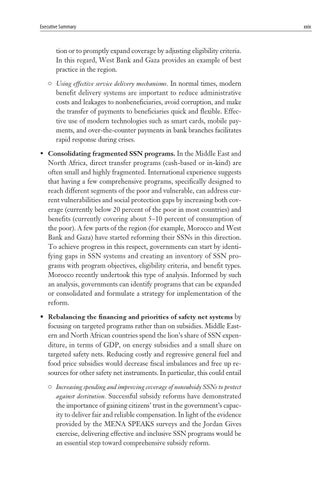xxviii
Inclusion and Resilience: The Way Forward for Social Safety Nets in the Middle East and North Africa
Executive Summary
Gaza, and the Republic of Yemen) in the direction of poverty-based targeting. Results in these places have demonstrated the power of such reforms and outlined a clear path forward.
tion or to promptly expand coverage by adjusting eligibility criteria. In this regard, West Bank and Gaza provides an example of best practice in the region.
C Improving the focus on SSN program results through M&E and social accountability. In the Middle East and North Africa, enhanced M&E for SSNs can help allocate budget resources among programs, monitor day-to-day operations, and track the results of interventions. M&E has been particularly effective when the evaluation results and empirical data are used to inform budgetary decisions and reshape programs. This was the case in West Bank and Gaza and the Republic of Yemen. Moreover, introducing well-functioning social accountability systems can improve efficiency and accountability and combat corruption.
C Using effective service delivery mechanisms. In normal times, modern benefit delivery systems are important to reduce administrative costs and leakages to nonbeneficiaries, avoid corruption, and make the transfer of payments to beneficiaries quick and flexible. Effective use of modern technologies such as smart cards, mobile payments, and over-the-counter payments in bank branches facilitates rapid response during crises.
C Reaching out to other stakeholders (citizens, NGOs, civil society organizations [CSOs], the private sector, and nonprofits). Citizens’ awareness about existing SSN programs is low and skewed toward the wealthy. On-demand registration requires awareness about the existence of programs, eligibility criteria, and application procedures. Comprehensive communication campaigns are needed to inform poor and vulnerable citizens of the safety nets that are available to them. Moreover, engaging a broader spectrum of stakeholders (such as NGOs, CSOs, the private sector, and nonprofits) in financing and implementing SSN programs could add leverage from their existing financial and human resources. • Establishing a reliable yet flexible SSN infrastructure that can be used in normal times as well as during crises. An effective SSN system can help citizens navigate the effects of idiosyncratic and systemic shocks. The recent global economic crisis underscored the weak capacity of existing SSN systems in the Middle East and North Africa to serve this function. Promoting households’ resilience to shocks through SSNs requires a strong administrative infrastructure. Having this infrastructure in place ahead of a crisis allows for quicker and more efficient development of remedial and mitigation actions, such as scaling up of benefits for the most vulnerable or expanding coverage, thus enhancing resilience. In particular, setting up an improved SSN infrastructure could entail the following: C Creating unified registries of beneficiaries that can be used to target multiple programs. In normal times, unified registries can reduce costs and facilitate coherence and convergence because all agents work with the same database. In times of crisis, unified registries can be used to quickly disburse additional benefits to the target popula-
• Consolidating fragmented SSN programs. In the Middle East and North Africa, direct transfer programs (cash-based or in-kind) are often small and highly fragmented. International experience suggests that having a few comprehensive programs, specifically designed to reach different segments of the poor and vulnerable, can address current vulnerabilities and social protection gaps by increasing both coverage (currently below 20 percent of the poor in most countries) and benefits (currently covering about 5–10 percent of consumption of the poor). A few parts of the region (for example, Morocco and West Bank and Gaza) have started reforming their SSNs in this direction. To achieve progress in this respect, governments can start by identifying gaps in SSN systems and creating an inventory of SSN programs with program objectives, eligibility criteria, and benefit types. Morocco recently undertook this type of analysis. Informed by such an analysis, governments can identify programs that can be expanded or consolidated and formulate a strategy for implementation of the reform. • Rebalancing the financing and priorities of safety net systems by focusing on targeted programs rather than on subsidies. Middle Eastern and North African countries spend the lion’s share of SSN expenditure, in terms of GDP, on energy subsidies and a small share on targeted safety nets. Reducing costly and regressive general fuel and food price subsidies would decrease fiscal imbalances and free up resources for other safety net instruments. In particular, this could entail C Increasing spending and improving coverage of nonsubsidy SSNs to protect against destitution. Successful subsidy reforms have demonstrated the importance of gaining citizens’ trust in the government’s capacity to deliver fair and reliable compensation. In light of the evidence provided by the MENA SPEAKS surveys and the Jordan Gives exercise, delivering effective and inclusive SSN programs would be an essential step toward comprehensive subsidy reform.
xxix
